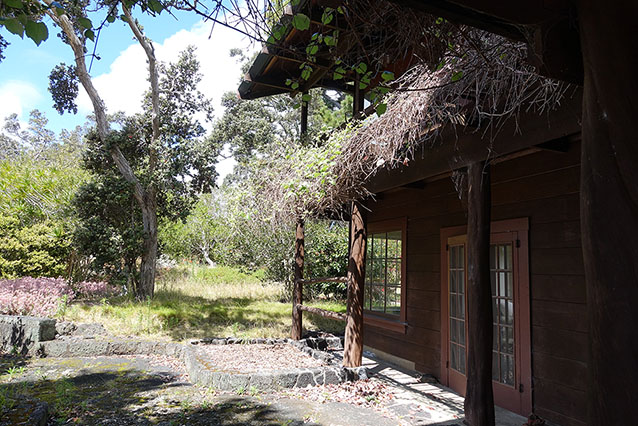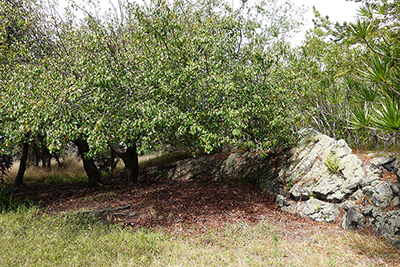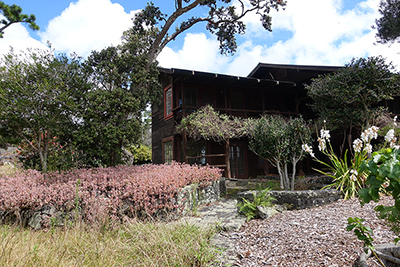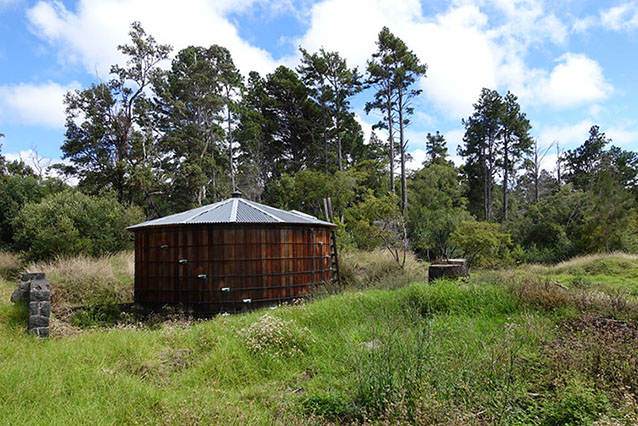The 'Ainahou Ranch House and Gardens is located within Hawai'i Volcanoes National Park, approximately four miles south and down slope from Kilauea Caldera. The site is locally significant for the period from 1941 to 1971 for its association with Herbert C. Shipman, a locally renowned horticulturalist, businessman, cattle rancher, wildlife conservationist, philanthropist, and descendant of one of the oldest missionary families in Hawai'i.
The gardens of the 'Ainahou Ranch House continue to represent Herbert C. Shipman's creation of an isolated yet elaborate sanctuary in the forest. His development of the site into an architectural and horticultural showcase is still evident.

NPS

NPS
Within the forest, gardens that surround a unique craftsman house create an exotic setting which reflects the site's development by renowned horticulturalist, Herbert C. Shipman from 1941 to 1971. During these years, Shipman created an informal historic vernacular landscape that showcased his vast horticultural collection, which included orchids, orchards, a tree farm, and rare plants from around the globe. These plantings were all supported by an on-site rare plant nursery and an ingenious and unique rainwater catchment system.
Shipman's efforts were intended to develop an aesthetic horticultural showcase to display his collections and beautify the grounds of his unique home, rather than to create a botanic garden in a traditional sense with specific areas dedicated to species, ecosystems, or parts of the globe. The gardens were informally planted throughout the grounds, making use of the sloping terrain to create views to the shoreline. Smaller topographic lava features were used as planters or as backdrops for orchids and other species. The palette consisted of a multitude of exotic species laid out in an informal, non-linear pattern, which in several areas incorporated or even accentuated the existing natural patterns of native trees and rock outcrops.
While Shipman utilized many exotics in discrete arrangements throughout his gardens, the layout does not adhere to any known formally-designed plan and does not follow any thematic organization that might be used to categorize the developments as botanical gardens or as a formally designed landscape. As a result, the 'Ainahou Ranch House and Gardens is a historic vernacular landscape.

NPS
The period of significance from 1941 to 1971, established in the National Register of Historic Places documentation, begins when Shipman first constructed his house as a safe haven from possible Japanese invasion during World War II. During and after the war, the ranch house was also used as a base of operations for 'Ainahou Ranch, which supplied beef to military and domestic outlets. The ensuing years saw more elaborate gardens surrounding the ranch house, and the site was used as a Nene (endangered Hawaiian goose) sanctuary. Shipman is further credited with saving the Nene from extinction.
The period ends in 1971 when Shipman submitted his asking price for his improvements to the property, and terminated his lease with B.P. Bishop Estate, thereby enabling the National Park Service to acquire it from the owner.
The current variety of plant species found at the 'Ainahou Ranch House and Gardens is significantly more limited than it was during the period of significance. Shipman removed many plants between 1973 and 1975, and the NPS has had to eradicate some of the invasive contributing species. However, the overall character of the site as a manicured showcase of exotics within a native mesic forest remains. This is due in part to efforts by both the NPS and the Friends of 'Ainahou, a volunteer organization dedicated to maintaining the property. As a result, the following landscape characteristics contribute to the significance of the National Register of Historic Places site: natural systems and features, topography, buildings and structures, cluster arrangement, spatial organization, vegetation, circulation, and land use. However, due to the removal of fences and the rapid encroachment of primarily invasive forest species, the small scale features and views and vistas landscape characteristics no longer remain.

NPS
Although the 'Ainahou Ranch and Gardens no longer functions as a residence or a ranch, its current use as a wilderness destination for hosting educational groups and botanical societies, a working nursery, and a Nene sanctuary is compatible with historic land uses.
Quick Facts
- Cultural Landscape Type: Vernacular
- National Register Significance Level: State
- National Register Significance Criteria: B, C
- Period of Significance: 1941 - 1971
Landscape Links
Last updated: December 30, 2020
